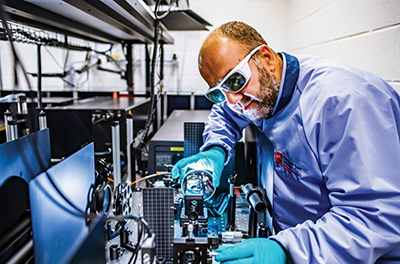Research will spark new generation of high-quality, low-cost infrared imaging
12/05/2025
Researchers are developing state-of-the-art camera technology, which for the first time will bring high resolution to the entire range of infrared imaging.
The Nottingham Trent University (NTU) research will also make it possible to detect, view and switch between the full infrared range in one place, something that is not possible with current technology.
The work is being made possible through a €3 million (approximately £2.6 million) grant from the European Research Council, awarded to Mohsen Rahmani, Professor of Engineering with NTU’s School of Science and Technology, and his Advanced Optics and Photonics team.
While visual cameras, such as those used in smartphones, are very well developed and offer high resolution and clarity, this is not currently possible with infrared or thermal imaging cameras, where the images appear blurry due to less developed sensors working at infrared ranges.
Infrared cameras are critical for a wide range of applications, from the near-infrared range, just beyond the visible spectrum, through to the long-infrared range.
The infrared imaging market size was valued at $7.03 billion in 2023 and is projected to reach $12.36 billion by 2032.
Uses include food quality control, night vision, medical imaging or monitoring for heat or gas leakages.
Currently, a separate camera is required depending on the infrared range and these are expensive to buy and consume a lot of power.
The NTU research – Universal Platform for Infrared Imaging (UPIRI) – will make it possible to detect all infrared bands simultaneously for the first time and will be fully integrable with existing smartphone and well-developed regular camera technology.
Building on the existing research of Professor Rahmani and his team, the five-year study will involve the development of a layer of engineered arrays of nanoparticles, known as metasurfaces, that can absorb all infrared bands and convert them to visible light.
These metasurfaces can be configured to be pixelated to offer higher resolutions and independently controlled to switch between different infrared bands.
 | ||
| Professor Mohsen Rahmani |
The aim is for the new platform to provide a quality alternative to today’s expensive and complex semiconductor technology for infrared imaging.
“Our ambition is to have all of the visible and infrared bands together in high resolution in one inexpensive device,” said Professor Rahmani, who leads NTU’s Advanced Optics and Photonics Lab.
He continued: “Infrared cameras are critical for many applications, but these rely on cameras to work at different infrared sub-bands. No single camera can detect all bands. They are also low in pixels with poor image quality, expensive and heavy on energy consumption.
“We aim to generate a new addition to visible cameras, technology which is not currently compatible with our everyday technologies but can be easily incorporated. We can do this with the creation of a compact nanoscale layer, which sits between the other layers of a standard camera.
“Working alongside my team, this European Research Council Consolidator Grant will help us to combine all of our research and expertise into this one impactful outcome.”
Professor Richard Emes, Pro Vice Chancellor Research and International at NTU, said: “This award is recognition of the exceptional people and research environment at Nottingham Trent University.
“We are immensely proud of Mohsen Rahmani and the wider Advanced Optics and Photonics team and look forward to seeing the exciting results to come.”